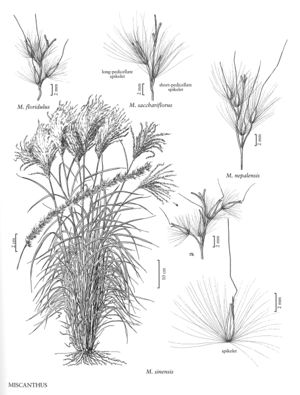Miscanthus sacchariflorus
Plants rhizomatous, rhizomes 3-6 mm wide. Culms 60-250 cm tall, 5-8 mm thick below; nodes pilose. Leaves evenly distributed; ligules 0.5-1 mm; blades 20-80 cm long, 0.5-3 cm wide, adaxial surfaces densely pilose basally, midribs prominent, whitish. Panicles 15-40 cm long, 8-16 cm wide, white to yellowish-brown, usually with more than 15 branches; rachises 4-10 cm; nodes pilose; branches 10-35 cm long, about 10 mm wide, sometimes branching at the base. Shorter pedicels 1.5-3 mm; longer pedicels 3-7 mm, strongly curved at maturity. Spikelets 4-6 mm; callus hairs 2-4 times as long as the spikelets, copious, white. Lower glumes 2-keeled above, margins densely pilose distally, hairs to 15 mm; upper glumes 4-5 mm, 3-veined, margins ciliate distally; awns of upper lemmas absent or short, not exceeding the glumes. 2n = 38, 57, 64, 76, 95.
Distribution
Mass., Ont., Que., Mo., Minn., Mich., Nebr., Wis., N.Y., Ill., Conn., Maine, Iowa
Discussion
Miscanthus sacchariflorus is native to the margins of rivers or marshes in temperate to north-temperate regions of eastern Asia, and appears to require cold and humidity for optimum growth. It has escaped from cultivation in various parts of the Flora region. It combines a large, plumose panicle with recurving leaves that turn orange in the fall.
Selected References
None.
Lower Taxa
"decumbent" is not a number."fine" is not a number.
